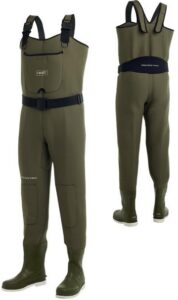 Hello everyone, today I’m going to discuss wader options for the fisherman. In today’s market out there we have the inexpensive waders such as nylons or the PVC waders which are going to be your lowest clot and price option. The major disadvantage of these waders is that they tend not to last very long, they break down very rapidly in most situations. They are also very easily punctured and they just wear out fast. So, our focus todays on neoprene and breathable waders. We will discuss pros and cons of the two. And offer you the best choices as a fisherman. Neoprene was the hot item then they first came out on the market, it was 25 years ago and they were 3 times as expensive as they are today actually. They’ve come down drastically in price mainly because the demand for neoprene waders has gone way down with the advancements and the price reduction in breathable waders. Breathable waders is made from a fabric that allows water vapor to escape through the membranes of the wader but yet will allow a larger water molecule to penetrate into the wader, therefore they are waterproof. Modern breathable waders have zippers that are actually waterproof, don’t ask me how it works, but they actually do work because I have seen them and used them and they really are waterproof. Now neoprene wader is just what it sounds like, wader that is constructed of neoprene rubber. All the modern ones are now lined on the inside as well as the outside.
Hello everyone, today I’m going to discuss wader options for the fisherman. In today’s market out there we have the inexpensive waders such as nylons or the PVC waders which are going to be your lowest clot and price option. The major disadvantage of these waders is that they tend not to last very long, they break down very rapidly in most situations. They are also very easily punctured and they just wear out fast. So, our focus todays on neoprene and breathable waders. We will discuss pros and cons of the two. And offer you the best choices as a fisherman. Neoprene was the hot item then they first came out on the market, it was 25 years ago and they were 3 times as expensive as they are today actually. They’ve come down drastically in price mainly because the demand for neoprene waders has gone way down with the advancements and the price reduction in breathable waders. Breathable waders is made from a fabric that allows water vapor to escape through the membranes of the wader but yet will allow a larger water molecule to penetrate into the wader, therefore they are waterproof. Modern breathable waders have zippers that are actually waterproof, don’t ask me how it works, but they actually do work because I have seen them and used them and they really are waterproof. Now neoprene wader is just what it sounds like, wader that is constructed of neoprene rubber. All the modern ones are now lined on the inside as well as the outside.
Key Takeaways:
- Neoprene waders offer superior warmth and flexibility compared to other materials.
- Understanding the distinct features of neoprene waders helps in making an informed decision.
- Comparisons with other materials highlight neoprene’s unique advantages in specific fishing conditions.
Most people have been hunting for neoprene for a while now, that is what they are used to now, way back when they didn’t have this material people wearing canvas waders, they were way worse and not warm at all also very difficult to move in. The ones that came out first were not lined in the inside and they were extremely uncomfortable if you wore them in a hot situation. The lining inside makes them a little bit more comfortable when the weather is warm. Neoprene waders are recommended for very cold-water environment. For example, if you are going to Alaska where the ambient temperatures not going to exceed about 60 degrees, it’s going to be rainy, the water is glacial melt-water so it’s very cold. That is in a situation where the neoprene wader is your best option. Or if you are going float tubing for instance or kick boating and you are going to be mostly submerged in the water in a very cold water environment, maybe you are going to a lake as the ice is coming off of it – neoprene is your best option in such situations.
Advantages
- Warmth – it’s the top advantage comparing to other waders, especially over breathable ones. Neoprene is made to keep all your body heat trapped inside. There are various thicknesses and you should choose one that suits your needs best, it depends on the temperature of the water, thinnest generally is at 3 millimeters. No other waders can outperform neoprene for keeping you warm in terms of time.
- Mobility – as you know neoprene is used in various suits, and diving suit is no exception. Fabric is formfitting and this makes it good for easy mobility. Neoprene is also a highly buoyant which is a huge ting for float tubing.
- Longevity – neoprene waders will outlive any other type of waders including breathable ones by a long shot. The durability of this material allows the waders to last for at least 20 years. If you compare to breathable waders, they last only 5 years according to polls and answers from consumers. Neoprene can be repaired without a lot of hassle, for example if a hook rips a hole being the water – instant bonding superglue will do the work.
- 100% waterproof – you can be sure that no water will come in if you use them. To get this result you have to sacrifice one thing – they are not breathable but will keep you warm even in coldest water environment.
Top 4 Best Neoprene Waders
| PHOTO | NAME | SPECIFICATIONS | RATING(1-5) |
|---|---|---|---|
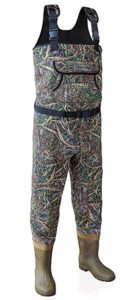 | Foxelli Neoprene Fishing Waders | 4.8 |
|
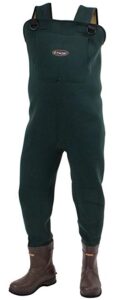 | Frogg Toggs Amphib Neoprene Bootfoot Chest Wader | 4.2 |
|
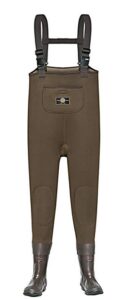 | Yong Chao Men's Chest Wader | 4.6 |
|
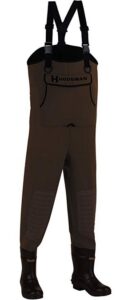 | Hodgman Caster Neoprene Felt Boot-Foot Chest Wader | 4.0 |
How to Patch Neoprene Waders
Neoprene is a great material to paddle sports. Occasionally you may need to fix a hole rip in the fabric. In this video you can see how to do that.
Today you can find a lot of choices of wader material, but neoprene is still widely used by fisherman and other people who need a trusted protection from cold in their activities in water. We listed best neoprene wader options for you to consider, from simple chest ones to hip, and hope that you will make a wise choice and will not regret it.
Choosing the Best Waders for Fishing: The Benefits of Neoprene
Fishing, an activity that harmonizes with nature’s serenity, demands not only skill and patience but also the right gear. Among the most critical pieces of equipment for anglers are waders. They keep you dry and comfortable, allowing for an immersive fishing experience. This article delves into the world of waders, focusing particularly on those crafted from neoprene, a material revered by many in the fishing community.
1. Understanding Neoprene Waders
Neoprene, a synthetic rubber, is famed for its excellent insulation properties and flexibility. It was introduced as a wader material in the latter part of the 20th century and revolutionized cold-water fishing. Neoprene waders are typically available in thicknesses ranging from 3mm to 7mm, catering to different environmental conditions.
Benefits of Neoprene Waders:
- Insulation: The most significant advantage of neoprene is its ability to retain heat. The material traps a thin layer of water between your body and the wader, which your body heat warms, creating an insulating layer.
- Durability: Neoprene is known for its toughness. It resists abrasions and punctures better than most other materials, making it ideal for fishing in rough terrains.
- Flexibility: Despite its thickness, neoprene allows for a reasonable range of motion, essential for activities like wading through water and casting lines.
2. Neoprene vs. Other Wader Materials
When comparing neoprene waders to those made from other materials like nylon or breathable fabrics, several differences become apparent:
- Warmth vs. Breathability: Neoprene excels in cold water conditions, providing unmatched warmth. However, in warmer climates or during strenuous activities, breathable waders made from materials like GORE-TEX offer better air circulation.
- Weight and Comfort: Neoprene waders are heavier, which can be an advantage in providing stability in strong currents. However, for long hours or in warmer weather, the lighter breathable waders might be more comfortable.
- Cost-Effectiveness: Generally, neoprene waders are more affordable than high-end breathable ones, making them an excellent choice for anglers on a budget.
3. Selecting the Right Neoprene Waders
Choosing the right neoprene waders involves considering several factors:
- Thickness: Choose the thickness based on your typical fishing environment. Thicker neoprene offers more warmth but less flexibility.
- Fit and Size: Ensure they fit well but with enough room for layering clothes underneath. Adjustable straps and belts can help achieve a comfortable fit.
- Boot Types: Waders come with either boot-foot or stocking-foot designs. Boot-foot waders are convenient, while stocking-foot types offer better fit and require separate wading boots.
4. Care and Maintenance
To prolong the life of neoprene waders, proper care is crucial:
- Cleaning: Rinse them with fresh water after each use, especially if used in saltwater.
- Storage: Hang them in a cool, dry place away from direct sunlight to prevent degradation of the neoprene.
- Repairs: Small punctures or tears can be repaired with neoprene-specific adhesives.
5. Environmental Considerations
While neoprene offers many benefits, it’s essential to consider its environmental impact. Neoprene is not biodegradable, and its production can be energy-intensive. Anglers committed to environmental conservation might look into newer, eco-friendlier options.
In conclusion, neoprene waders stand out for their warmth, durability, and affordability. They are an excellent choice for anglers fishing in colder waters or rugged conditions. By understanding their features and how they compare to other materials, anglers can make an informed decision that enhances their fishing experience while keeping them comfortable and dry. Remember, the right waders not only protect you from the elements but also enhance your connection with the tranquil yet unpredictable nature of water bodies.